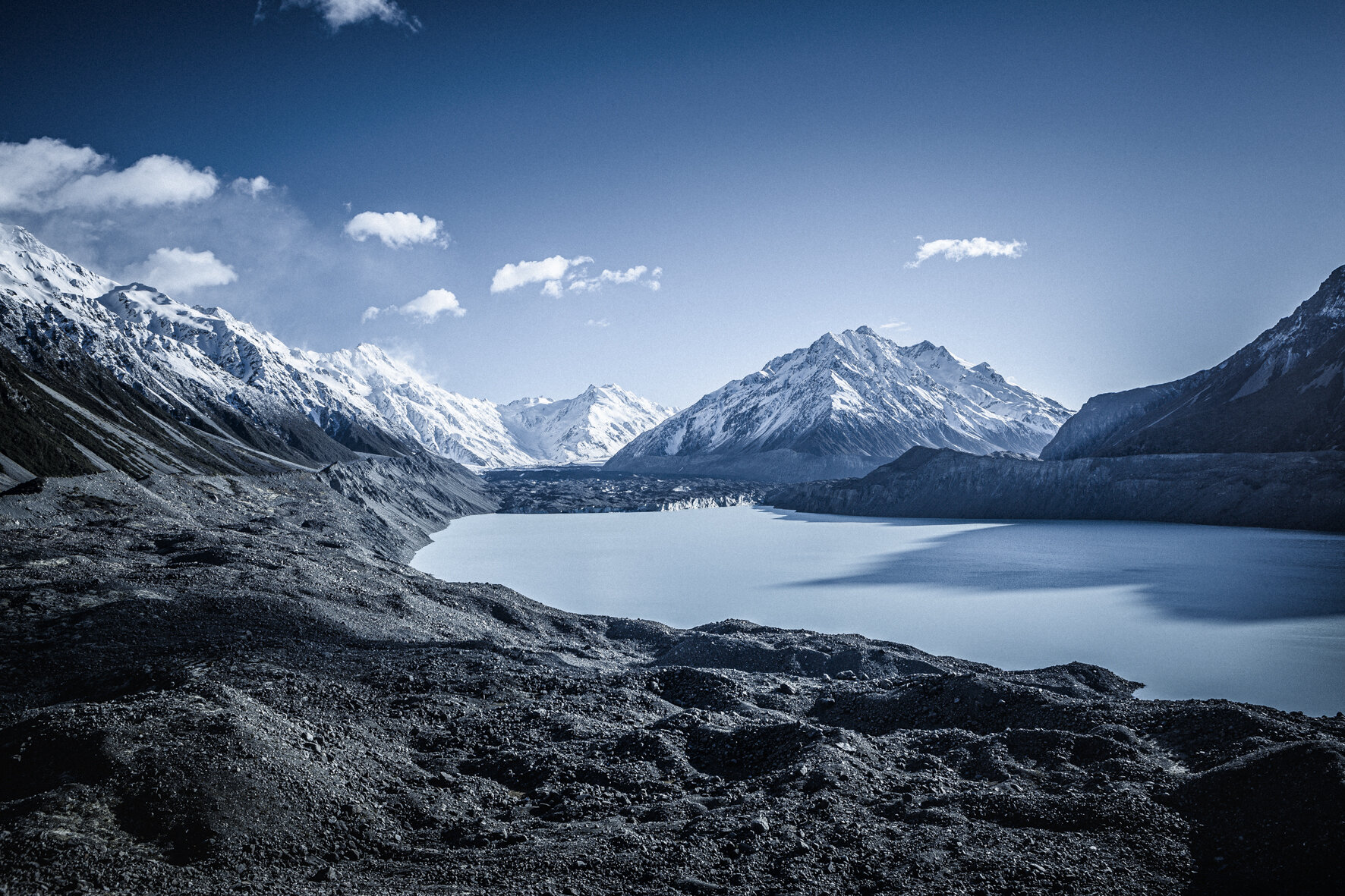OF PEAKS AND PETALS
Words by Adrian Hatwell
One of the country’s top advertising photographers grounds himself in soil and shale, as Spid Pye turns his lens on the metaphysical beauty of our land
Spid Pye is one of Aotearoa’s most sought after commercial shooters. His idiosyncratic approach to portraiture has won over big clients both here and abroad, and he’s pulled in a number of the most prestigious international photography awards along the way. But for his most recent personal project, Spid decided to deviate from what he’s known for to explore metaphysical questions of life and death through a juxtaposition of breathtaking landscapes and intimate still life imagery.
The Fleeting and the Abiding is the name the photographer has given this new series of work, evoking both the transient life cycle of flora and the enduring bedrock of geology. Fresh from being named one of the top 200 advertising photographers in the world by Lüerzer’s Archive, you might wonder how such a busy pro finds time to explore his own creative projects – but Spid says when you have his passion for photography “there’s nothing better than trying to create something unique”.
The idea of exploring the notion of lifecycles and what comes after death originated when the photographer experienced a personal loss – the passing of his father.
“The idea came from a picture I took of the Remarkables, just after my father’s death,” Spid explains. “In that picture, I could clearly see an old man lying in the landscape. For me, that ridgeline represents my father lying in the mountains, waiting for the next phase of his existence.”
Stare deeply into The Remarkable Old Man image and you might not be able
to locate Spid’s father, but you will doubtless be engrossed in the way the stoic mountain range seems to collide with the wispy fog of the lowlands. A scene that will last forever as stone but will never occur quite the same way again as mist; a beautiful encapsulation of the photographer’s aim for the project.
Working up and down the country on commercial shoots, Spid had ample opportunity to scout similarly evocative landscapes. Images from Ruataniwha Conservation Park, Aoraki/Mount Cook, Manakau, Moutere, and more have been shot with pristine craft and an intriguing eye for the ethereal.
These behemoths of the skyline are only half the tale of The Fleeting and the Abiding. Just as our concepts of the afterlife often include what is above and what is below, so too does Spid’s lens vacillate – from looking upon towering mountains, to zooming down on minute detail in elegant floral still life photos. These too have their origin in Spid’s personal life – his partner, Rachel, asked him to make a photo from a bunch of Peonies that she loved, so in a way they could be kept forever.
“The original idea behind the Peony image was ‘fading sexual currency’,” he says. “I think we are too attached to the idea that beauty and sex appeal are synonymous with youth and freshness. I wanted to show that where some might see these flowers as past their ‘use by date’, they were even more beautiful in their ageing.
“I wanted to shoot the classics and challenge myself to produce something different with each flower with the same idea.”
Although you wouldn’t know it to look at his professional portfolio, the photographer’s proficiency in the genre is no surprise, given that his past training background includes a stint assisting a professional still life photographer.
Spid grew up on a Hauraki Plains farm and, despite the remote locale, had plenty of access to creative culture thanks to the musical interests of his eight older brothers and sisters.
“They were into their music so we had loads of records lying around and I was always intrigued by the characters on the music covers,” he recalls, foreshadowing his own proficiency for evoking character through portraiture.
At the age of about nine, Spid had been promoted to chief family photographer of the house, and by 13 he decided that photography was what he wanted to do with his life. After leaving school at 15, he became an apprentice to an electrician, the money from which he quickly invested in a Minolta X-300 35mm film camera with 50mm lens.
His self-taught photography journey eventually led him to London and art school before he returned home and won a Ronald Woolf Memorial Trust grant to study photography and graphic design at Auckland’s AUT in the 90s. From there it was into full-time assisting gigs, one with fashion photographer Melanie Bridge, and another with still life photographer Mark Lever, before going freelance in 1997.
In the ensuing decades, Spid rose to the top of the commercial ranks, honing a practice of creating imagery that radiates character and spontaneity, while holding tight to important detail and subtleties. These instances of what he calls “life’s theatre” have been sought after by diverse brands such as Singapore Airlines, Coke, Nokia, McDonalds, Jockey, Dave Dobbyn, Auckland City Council, Huggies, Watties, Genesis, and more. Over that time his accolades have included wins at the Lürzer’s Archive, International Photography Awards, Communication Arts Photography Competition, Effie Awards, Campaign Brief’s The Work and NZ Marketing Awards, among others.
Although the images of The Fleeting and the Abiding do not instantly resemble the quirky, humorous portraits that have become his signature, close attention shows the photographer’s ability to invoke character – even in the absence of a human subject – very much persists in this personal work. These images present the verbal tics of geography, the idiosyncratic facial features of the flora. The land is many things to many people, and it is clear that for Spid, it is as much a cast of characters as it is a stage itself.
What the photographer ultimately hopes viewers will find in these images of life and death at various speeds is a moment of recognition. He presents the character of the land as he has perceived it in his journeys, and it is a character he hopes the audience might find recognisable, somewhere within their memory.
“Whether it be the hydrangeas on grandma’s driveway that they remember, or the rainbows that would appear out the window as a child – nostalgia – I want the viewer to feel something about the work and hopefully share it with their friends.”
It’s not a rose-tinted, picture postcard version of nostalgia Spid wishes to conjure, however. His frames contain darkness and beauty, ideal and flawed, drama and serenity in equal measure. As with his images of people, it’s not the typical ideal of beauty he works with but the spaces where imperfection is allowed to live: “It’s where you find the character.”
The Fleeting and the Abiding was shown in Auckland late last year, at the popular Ponsonby Central marketplace. The public was able to view and purchase pieces from the series and, while Spid has no plans to show the works again at this point, prints are still available to purchase through the artist’s website (spid.co.nz).
Keeping the creative momentum rolling into 2021, he already has plans for his
next personal project; a tragic, character-driven tale of love and loss that he is calling The Sleeping Lady. This will be one to watch out for because, as the images featured here demonstrate, over a career that has been anything but fleeting, Spid’s passion for photography is ever abiding.










